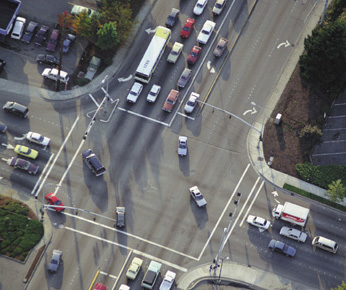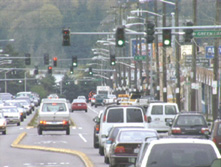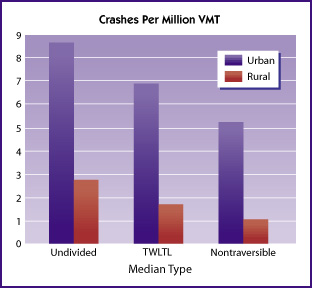| Skip
to content |
|
|
|
Arterial ManagementThis publication is an archived publication and may contain dated technical, contact, and link information.Arterial Management Challenges In many major metropolitan areas, the freeway system is functioning at or beyond the capacity for which it was designed. Many drivers are choosing to use arterial streets instead. The resulting stress on the arterial systems creates gridlock on the thoroughfares that define our cities and suburbs. Fortunately, the Federal Highway Administration's (FHWA) Office of Operations has identified effective ways to manage this growing trend. What We've LearnedArterial Management strategies are used to effectively and successfully manage traffic and control arterial roadways. Examples are:
 Traffic signal improvements include updating equipment, updating timing plans, and interconnecting signals. Over 75 percent of the country's 330,000 signals could be improved by updating the equipment or by simply adjusting the timing. Traffic signal retiming alone can produce benefit cost ratios as high as 40 to 1. That is, for every $1 invested in optimizing the timing or traffic signals, $40 is returned to the public in time and fuel savings. Advanced traffic signal control involves coordinating groups of signals, operating signal control systems that respond and adapt to traffic needs, or installing a priority control system. Installing advanced computerized controls can result in a 20 percent reduction in travel time when compared to noninterconnected pre-timed signals operating with old timing plans. Traffic monitoring on arterials can include incident detection and follow-up action to remove incidents, intersection surveillance and monitoring using loop detectors and video monitoring, and area-wide traffic surveillance. The Automated Traffic Surveillance and Control Program in Los Angeles , California uses a computerized signal control system that has been in operation since 1984. It manages 1,170 intersections and 4,509 detectors for signal timing optimization. The program has resulted in a 13 percent decrease in fuel consumption, 14 percent decrease in emissions, 41 percent reduction in vehicle stops, 18 percent reduction in travel time, 16 percent increase in average speed, and a 44 percent decrease in delay. Access management is a set of techniques that State and local governments can use to control access to highways, major arterials, and other roadways. The benefits of access management include improved movement of traffic, reduced crashes, and fewer vehicle conflicts. Four proven access management techniques are: Access Spacing: Increasing the distance between traffic signals improves the flow of traffic on major arterials, reduces congestion, and improves air quality for heavily traveled corridors. Driveway Spacing: Fewer driveways spaced further apart allow for more orderly merging of traffic and present fewer challenges to drivers. Turning Lanes: Dedicated left- and right-turn lanes, indirect left-turns and U-turns, and roundabouts keep through-traffic flowing. Roundabouts represent a potential solution for intersections with many conflict points. Median Treatments: Two-way left-turn lanes (TWLTL) and nontraversible, raised medians are examples of some of the most effective means to regulate access and reduce accidents. The safety benefits of median improvements are shown below. Studies indicate a decrease in crashes of 40 to 70 percent when these treatments are implemented.  D
D
Future DirectionThe Office of Operations Arterial Management program covers three major focus areas: arterial management, traffic signal timing, and access management. The program addresses research and development and deployment support initiatives. Research and development projects enhance tools such as algorithms for traffic signal software, traffic detection devices, or tools to aid in the collection of data. ACS Lite is a current initiative involving the modification of existing adaptive control software to allow it to operate on legacy traffic signal systems. Deployment support programs distribute and demonstrate current technology ready to be used by our transportation partners. Activities include developing training, technical documents, handbooks and manuals for transportation practitioners, and the continued revitalization and delivery of formal National Highway Institute training courses such as those covering Computerized Traffic Signal Systems and Traffic Control Signalization and Software. These courses are being formatted for Web-based delivery so practitioners around the country can learn on their own schedules. Future plans include continued expansion of the Traffic Signal Timing focus area to increase emphasis on communicating the importance of high quality, current traffic signal timing plans. A recent study of the signal timing process identified the steps necessary to reach optimally timed signals and where opportunities exist for automation and addressing issues such as staff shortages and budgetary constraints. These initiatives—achieved through research, education, outreach and guidance, and tool development - support the Office of Operation's goal of "21 st Century Operations using 21 st Century Technologies." For more information about Arterial Management visit https://ops.fhwa.dot.gov/arterial_mgmt/index.htm For more information on FHWA Office of Operations activities, visit our web site at https://ops.fhwa.dot.gov/index.asp April 2004 FHWA-OP-04-036
|
|
United States Department of Transportation - Federal Highway Administration |
Last modified: February 22, 2017 | |